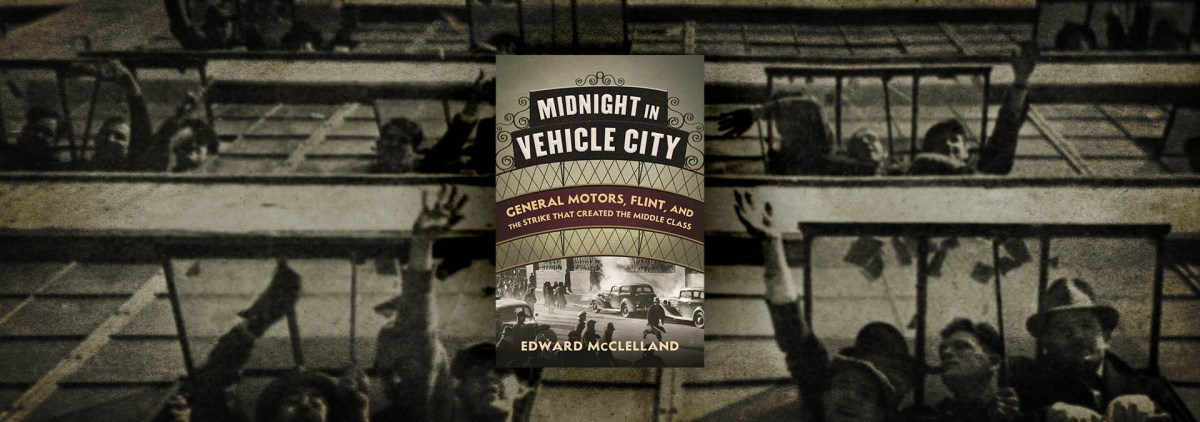[ad_1]
On December 30, 1936, workers took over the General Motors factory in Flint, Michigan and held it for 44 days, facing down bosses, vigilantes, and police. Through their strike, workers won a living wage, better working conditions, and recognition of their union, the United Automobile Workers of America (the UAWA, later known as the UAW). Labor’s victories in Flint and elsewhere drove up wages across the board for industrial workers, helping create the blue-collar middle class.
On the rare occasions when the Flint sit-down strike is taught in schools, it is taught as ancient history, a date to memorize, not as a vital story with lessons for the present. As an antidote to our collective amnesia, Edward McClelland offers his excellent new book, Midnight in Vehicle City: General Motors, Flint, and the Strike that Created the Middle Class. The book is more than an exciting story of worker Davids knocking down manager Goliaths—it is, McClelland writes, a “blueprint for better working conditions, and for a revival of the middle class.”
Instead of presenting a step-by-step plan for activism, McClelland tells stories of real men and women facing dire circumstances. To show the dangers workers faced in a GM factory run at breakneck speed, for instance, McClelland introduces “Neil Yaklin, [who] works half blind because a chip flies off a chisel when he’s driving rails into car bodies—forty or fifty rails a minute—and lodges in his eye. He loses the eye but keeps working because there is no disability pay or unemployment insurance.” In a world where lucky workers are the ones who are merely too exhausted at the end of their shift to speak to their families, what is to be done?
They struck.
McClelland describes in vivid detail how workers seized the plant, kicked out managers, welded shut exits, and turned industrial parts into makeshift weapons for the raids they knew would come. Crucially, McClelland emphasizes the key role women played in the strike, which is often misremembered as a macho standoff between union men on one side and company men on the other. Yes, men occupied the factory—the union wanted only men to face police violence and knew GM would undermine public support for a mixed-gender occupation by starting rumors of sexual liaisons between male and female strikers. Women outside the factory, however, were indispensable to the cause. Women kept up picket lines, broke up police charges, coordinated food deliveries, and rallied public support by delivering speeches, teaching classes on labor history, and putting on plays and screening movies with pro-labor messages (e.g., Charlie Chaplin’s Modern Times). The strike succeeded in Flint, McClelland makes clear, thanks in large part to the efforts of the women at its center.
One dynamic of the Flint story McClelland might have emphasized more is the dynamic of race. Early in the book, he notes how a White UAWA organizer sought to engage Black workers, who were usually given the dirtiest and most dangerous jobs at GM. The organizer told them, “We are not a Jim Crow union, nor do we have any second-class citizenship.” Elsewhere, McClelland notes how many White GM workers in Flint lived in tight-knit ethnic communities closed off to outsiders, but supportive of insiders. How, if at all, did these White workers take material steps to support their Black colleagues? How did union politics intersect with local and national politics of race? McClelland could have added more nuance to his excellent book if he had further explored how dynamics of race enabled or constrained the union in pursuing different goals, strategies, and tactics.
All told, what kind of blueprint is the story of the Flint sit-down strike? Wisely, McClelland does not say we should see 2021 as a repeat of 1936. For one thing, today’s most vibrant unions, including the Chicago Teachers Union and the Service Employees International Union, are more racially diverse than the old UAWA and pursue goals that speak to the needs of workers from different communities. For another thing, workers in 2021 labor in a high-tech global economy where companies can use the threat of automation and relocation as clubs to beat back workers’ advances.
Despite these differences, 2021 resembles 1936 insofar as workers can put their heads together to find the weak links and choke points in the system in which they labor. Indeed, the example of modern activism McClelland holds up at the end of the book—Amazon workers’ protests at delivery centers—does not focus on production, as the Flint workers did, but focuses, instead, on the circulation of goods. Different targets, same strategy of finding the system’s vulnerabilities and exploiting them to secure workers’ rights. It’s not hard to see in these Amazon workers the ingenuity and seriousness of purpose of their forerunners in Flint. In Midnight in Vehicle City, Edward McClelland draws out such lessons from the past and offers them up to workers fighting new battles in a long conflict.

NONFICTION
Midnight in Vehicle City:
General Motors, Flint, and the Strike that Created the Middle Class
By Edward McClelland
Beacon Press
Published February 2, 2021
[ad_2]
Source link
